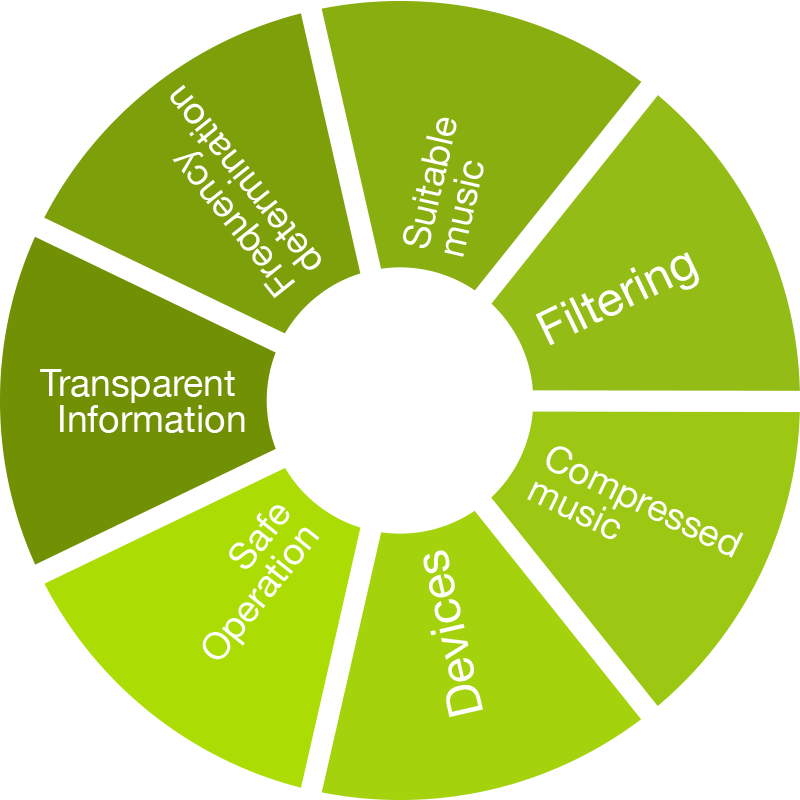Tailor-Made Notched Music Training - What to look for when selecting a provider
If you are interested in TMNMT and are trying to decide which provider is right for you, we recommend comparing offers to determine whether they meet certain quality criteria. The following is a list of the quality criteria to look for and how Tinnitracks compares:

1) Transparent Information
Ensure the therapy is specifically designed to treat subjective tonal tinnitus. Information on how to use the therapy and how it works should be as precise as possible. There should also be a glossary and contact information provided to address any other questions that arise. Any scientific studies that are referenced should be cited correctly. This allows one to assess whether manufacturer statements are actually endorsed by the scientific community.
Tinnitracks.com provides extensive information regarding the therapy’s respective individual suitability. Users are clearly advised to always coordinate their therapy with their ENT doctor. Direct links pertaining to all clinical studies on which Tinnitracks is based are also provided. This is a simple method for users to verify the claims and statements found on www.tinnitracks.com.
2) Frequency determination
In order for Tailor-Made Notched Music Training (TMNMT) to work, you will need a precise determination of your tinnitus frequency. This can only be performed by a trained professional. The test must be conducted under the guidance of an experienced audiometrist (hearing aid audiologist/ENT doctor) in order to obtain a precise and reliable measurement, as they are able to use special methods to determine your frequency and have the necessary equipment for such tests.
For testing purposes you will find an online matching tool on our website.
3) Filtering
Tailor-Made Notched Music Training is based on using music that has been correctly filtered with audio technology to make it suitable for therapy.
In order for music to be properly filtered for therapy, the signals in the music must meet the following criteria:
- extremely muted signals within the patient’s personal tinnitus frequency (“filtered out portion”).
- signals strongly retained, both in amplitude and phase, outside of the patient’s personal tinnitus frequency (“unfiltered portion”).
The frequency range between the filtered and unfiltered portions, which is necessary from a technical standpoint, ought to be as narrow as possible (“fast rise transition portion of the filter”).
The filtering process must not cause skips in the audio stream or lead to so-called clipping in the audio signal. Even slight distortions can cause interference signals to be dispersed into the patient’s personal tinnitus frequency range, which should be free of any signals during therapy.
Tinnitracks adjusts your filters correctly, both from a technical and a therapeutic standpoint, and does so fully automatically based on the tinnitus frequency entered. You can listen to your favorite music that is both technically and therapeutically correct for your Tailor-Made Notched Music Training.
4) Suitable music
It is also important that you use the right music for therapy:
It should, of course, be your personal choice of music. Listening to your favorite music releases feelings of happiness. These feelings automatically flood the brain with dopamine, improving the chances of successful therapy. Dopamine helps reorganize nerve cells in the brain. As articulated by the psychology of learning: It’s easier to learn when you’re having fun.
Moreover, each track must be professionally reviewed. Is the audio file appropriate for therapeutic use after it has been filtered? Can the track provide sufficient stimulation outside of the defined tinnitus frequency range over time with its density spectrum? Is it certain that the filtered music will not stimulate the set tinnitus frequency range?
Tinnitracks can be relied on to do the work of a trained audio engineer by not only filtering your favorite music, but also conducting an analysis of its therapeutic potential using an in-house developed process. The Tinnitracks software analyzes each filtered track to determine if it is suitable for therapy based on the individual’s tinnitus frequency. Tracks that are less suitable for therapy are marked with a red stoplight icon to indicate this to the user.
5) Compressed music
When evaluating providers, ensure the proper compression method is used. The MP3 is the most well-known process for compressing music. Most users prefer their music in this format in order to save space. Unfortunately, however, the traditional MP3 format offers very poor therapeutic quality.
Tinnitracks identified the deficiencies in this format that can negate the effects of listening to filtered music and developed a solution to solve this problem. Tinnitracks’ special MP3 format allows you to use the most popular audio format found online for your Tailor-Made Notched Music Training. MP3 files that have been processed by Tinnitracks retain the necessary therapeutic qualities while offering a file that is small in size, easy to manage, and compatible with any device.
6) Devices
Are you directed to the proper devices for use during therapy? A variety of headphones are suitable for therapy. The key is to use closed headphones with good ambient noise suppression and a low distortion factor in order to keep out any noise in the patient’s individual tinnitus frequency range. The headphones may not, however, have any active noise compensation. The signals may also not be wirelessly transmitted from the playback device to the headphones, as this compromises the audio signals in a way that is detrimental to therapy.
You should also be warned against using playback devices with so-called equalizer settings that change the sound qualities.
Tinnitracks informs users about the important qualities for their headphones and how to configure their playback device.
Tinnitracks.com also suggests select headphones to help users find the appropriate equipment for their therapy. The audio specialist company Sennheiser is our headphone partner and offers quality products with a low distortion factor. The engineers at Sonormed GmbH and Sennheiser collaborated to streamline individual frequency responses when using Tinnitracks with the recommended headphones. The combination of signal optimization and high quality headphones with a low distortion factor and excellent ambient noise suppression is ideal for therapy.
7) Safe Operation
It is also important to find a provider who can guarantee the therapeutic quality of the technical audio signal processing. This can be accomplished via trained employees or with reliable software.
Tinnitracks offers a software-based solution that is easy to use and features fully automated processes. Tinnitracks is also a medical product as defined in § 3 No. 1a of the German Medical Products Law (MPG) and is classified as a Class 1 medical product in accordance with Directive 93/42 (EEC), Annex IX, Rule 1. The CE seal for active medical products demonstrates conformity with the basic requirements of Directive 93/42 Annex 1 of the Council of the European Union.
Tinnitracks offers excellent customer service with representatives who are happy to answer any questions you may have.







 Tinnitracks Basis-Therapie
Tinnitracks Basis-Therapie